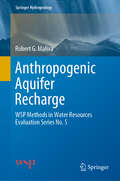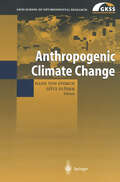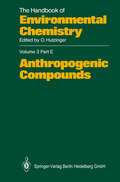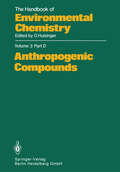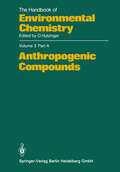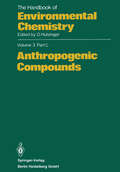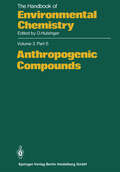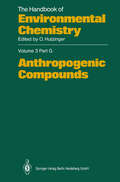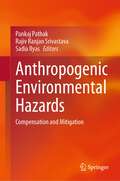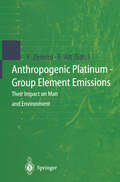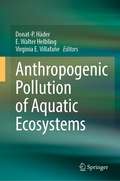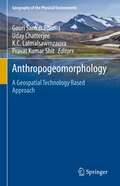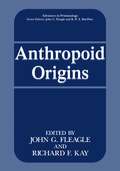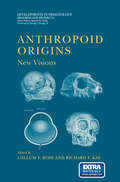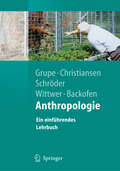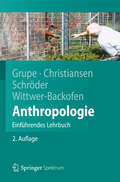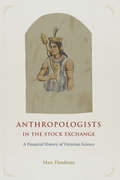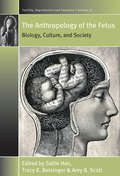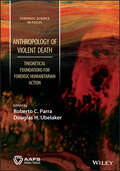- Table View
- List View
Anthropogenic Aquifer Recharge: WSP Methods in Water Resources Evaluation Series No. 5 (Springer Hydrogeology)
by Robert G. MalivaThe book is an overview of the diversity of anthropogenic aquifer recharge (AAR) techniques that use aquifers to store and treat water. It focusses on the processes and the hydrogeological and geochemical factors that affect their performance. This book is written from an applied perspective with a focus of taking advantage of global historical experiences, both positive and negative, as a guide to future implementation. Most AAR techniques are now mature technologies in that they have been employed for some time, their scientific background is well understood, and their initial operational challenges and associated solutions have been identified. However, opportunities exist for improved implementation and some recently employed and potential future innovations are presented. AAR which includes managed aquifer recharge (MAR) is a very important area of water resources management and there is no recent books that specifically and comprehensively addresses the subject.
Anthropogenic Climate Change (GKSS School of Environmental Research)
by Hans Von StorchGKSS SCHOOL OF ENVIRONMENTAL RESEARCH The National Research Laboratory GKSS (member of the Hermann von Helmholtz-Association of German Reserach Centres) located in Geesthacht, near Hamburg, is engaged in environmental research. The main interest of the research center focuses on regional climatology and climate dynamics, interdecadal variations in the state of the Baltic and North Sea and related estuaries, and the flow ofheavy metals, nutrients, and other materials in river catchments to the coastal zones. This research aims at-developing an under standing ofchanges in the environment, both as a result ofinternal (natural) dynamics and as a result of anthropogenic interference. In an effort to dis seminate the results of these research activities, as well as to initiate a broad discussion among senior scientists in the field, and younger colleagues from all areas of the globe, the Institutes of Hydrophysics and Atmospheric Physics at GKSS have instituted the GKSS School of Environmental Research. Appliedenvironmental research has always containedanelement ofaware ness ofthe societal implications and boundary conditions associated with en vironmental concerns. Consequently, the School of Environmental Research adheres to the philosophy that all discussion regarding environmental change should incorporate a social component. This necessity has been well acknowl edged and is apparent by the incorporation ofsocial scientists into the series of lectures. Senior scientists from Europe and North America were invited to give lectures to "students" from all parts of the globe.
Anthropogenic Compounds (The Handbook of Environmental Chemistry #3 / 3E)
by Freddy Adams Stephen J. Blunden Rudy Van Cleuvenbergen C. J. Evans Lawrence Fishbein Urs-Josef Rickenbacher Christian Schlatter Alfred SteineggerAn important purpose of The Handbook of Environmental Chemistry is to aid the understanding of distribution and chemical reaction processes which occur in the environment. It is designed to serve as an important source for environmental scientists and decision-makers in industry, governmental and regulatory bodies. Volume 3, Part E of this series is dedicated to organometallic compounds, aluminium and to chemicals used in the rubber industry.
Anthropogenic Compounds (The Handbook of Environmental Chemistry #3 / 3D)
by R. F. Addison A. B. McKague A. Larsson D. J. McLeay P. E. Ney G. A. Parker D. Rivin G. Sundström M. Tarkpea C. C. WaldenAnthropogenic Compounds (The Handbook of Environmental Chemistry #3 / 3A)
by Rudolf Anliker G. C. Butler E. A. Clarke U. Förstner W. Funke C. Hyslop G. Kaiser C. Rappe J. Russow G. Tölg M. Zander V. ZitkoEnvironmental Chemistry is a relatively young science. Interestin this subject, however, is growing very rapidly and, although no agreement has been reached as yet about the exact content and Iimits of this interdisciplinary discipline, there appears to be increasing interest in seeing environmental topics which are based on chemistry embodied in this subject. One of the first objectives ofEnvironmental Chemistry must be the study ofthe environment and of natural chemical processes which occur in the environment. A major purpose of this series on Environmental Chemistry, therefore, is to present a reasonably uniform view of various aspects of the chemistry of the environ ment and chemical reactions occurring in the environment. The industrial activities of man have given a new dimension to Environ mental Chemistry. Wehave now synthesized and described over five million chemical compounds and chemical industry produces about hundred and fifty million tons of synthetic chemieals annually. We ship billions of tons of oil per year and through mining operations and other geophysical modifications, large quantities of inorganic and organic materials are released from their natural deposits. Cities and metropolitan areas ofup to 15 million inhabitants produce large quantities ofwaste in relatively small and confined areas. Much of the chemical products and waste products of modern society are released into the environment either during production, storage, transport, use or ultimate disposal. These released materials participate in natural cycles and reactions and frequently Iead to interference and disturbance of natural systems.
Anthropogenic Compounds (The Handbook of Environmental Chemistry #3 / 3C)
by E. Atlas L. Fishbein C. S. Giam J. E. Leonard D.C.G. Muir M.A. Jr. Powers J. SchoerEnvironmental Chemistry is a relatively young science. Interest in this subject, however, is growing very rapidly and, although no agreement has been reached as yet about the exact content and limits of this interdisciplinary discipline, there appears to be increasing interest in seeing environmental topics which are based on chemistry embodied in this subject. One of the first objectives of Environmental Chemistry must be the study of the environment and of natural chemical processes which occur in the environment. A major purpose of this series on Environmental Chemistry, therefore, is to present a reasonably uniform view of various aspects of the chemistry of the environment and chemical reactions occurring in the environment. The industrial activities of man have given a new dimension to Environmental Chemistry. We have now synthesized and described over five million chemical compounds and chemical industry produces about hundred and fifty million tons of synthetic chemicals annually. We ship billions of tons of oil per year and through mining operations and other geophysical modifications, large quantities of inorganic and organic materials are released from their natural deposits. Cities and metropolitan areas of up to 15 million inhabitants produce large quantities of waste in relatively small and confined areas. Much of the chemical products and waste products of modern society are released into the environment either during production, storage, transport, use or ultimate disposal. These released materials participate in natural cycles and reactions and frequently lead to interference and disturbance of natural systems.
Anthropogenic Compounds (The Handbook of Environmental Chemistry #3 / 3B)
by K. J. Bock K. A. Daum E. Merian L. W. Newland C. R. Pearson H. Stache M. ZanderEnvironmental Chemistry is a relatively young science. Interest in this subject, however, is growing very rapidly and, although no agreement has been reached as yet about the exact content and limits of this interdisciplinary discipline, there appears to be increasing interest in seeing environmental topics which are based on chemistry embodied in this subject. One of the first objectives of Environmental Chemistry must be the study of the environment and of natural chemical processes which occur in the environment. A major purpose of this series on Environmental Chemistry, therefore, is to present a reasonably uniform view of various aspects of the chemistry of the environment and chemical reactions occurring in the environment. The industrial activities of man have given a new dimension to Environmental Chemistry. We have now synthesized and described over five million chemical compounds and chemical industry produces about hundred and fifty million tons of synthetic chemicals annually. We ship billions of tons of oil per year and through mining operations and other geophysical modifications, large quantities of inorganic and organic materials are released from their natural deposits. Cities and metropolitan areas of up to 15 million inhabitants produce large quantities of waste in relatively small and confined areas. Much of the chemical products and waste products of modern society are released into the environment either during production, storage, transport, use or ultimate disposal. These released materials participate in natural cycles and reactions and frequently lead to interference and disturbance of natural systems.
Anthropogenic Compounds (The Handbook of Environmental Chemistry #3 / 3G)
by Franzkarl Brochhagen Elizabeth P. Burrows Heidelore Fiedler J. Konietzko Wayne R. Mitchell Klaus Mross W. Mücke David L. Parmer David H. RosenblattEnvironmental Chemistry is a relatively young science. Interest in this subject, however, is growing very rapidly and, although no agreement has been reached as yet about the exact content and limits of this interdisciplinary subject, there appears to be increasing interest in seeing environmental topics which are based on chemistry embodied in this subject. One of the first objectives of Environ mental Chemistry must be the study of the environment and of natural chemical processes which occur in the environment. A major purpose of this series on Environmental Chemistry, therefore, is to present a reasonably uniform view of various aspects of the chemistry of the environment and chemical reactions occurring in the environment. The industrial activities of man have given a new dimension to Environ mental Chemistry. We have now synthesized and described over five million chemical compounds and chemical industry produces about one hundred and fifty million tons of synthetic chemicals annually. We ship billions of tons of oil per year and through mining operations and other geophysical modifications, large quantities of inorganic and organic materials are released from their natural deposits. Cities and metropolitan areas of up to 15 million inhabitants produce large quantities of waste in relatively small and confined areas. Much of the chemical products and waste products of modern society are released into the environment either during production, storage, transport, use or ultimate disposal. These released materials participate in natural cycles and reactions and frequently lead to interference and disturbance of natural systems.
Anthropogenic Environmental Hazards: Compensation and Mitigation
by Pankaj Pathak Rajiv Ranjan Srivastava Sadia IlyasThis book delves into the anthropogenic activities responsible for environmental hazards, their compensation, and potential mitigation strategies. It sheds light on the major contributors to the climate change issues aggravated by non-sustainable practices for the overexploitation of natural resources. Critical topics such as high emissions in primary mining, the recovery of energy-critical metals by urban mining, solid waste management, and forest conservation are explored, offering insights into the urgent challenges we face.Amidst the rapid demand for resources and the expansion of human habitats, the book emphasizes the need for new approaches to natural resource management and introspection of our actions. Experts in the field discuss existing anthropogenic environmental hazards in detail, alongside environmental compensation, and effective mitigation approaches.The book begins with a chapter dedicated to risk assessment in primary mining activities for precious metals, proposing potential routes for mitigation. Chapter 2 focuses on assessing and mitigating the environmental footprints of energy-critical metals used in permanent magnets. In Chapter 3, a case study examines sustainable resource utilization through end-of-life room air conditioner recycling. Additional chapters provide critical insights into:The environmental impacts of e-waste and government policies for responsible managementHazards associated with industrial effluents and corresponding mitigation strategiesThe role of roadside plants in phytoremediation of heavy metal pollutionSustainable utilization of anthropogenic coal fly ash through mechanical and chemical activationEnvironmental damages resulting from the mismanagement of municipal solid wasteEnvironmental problems and remediation strategies for anthropogenic biomass wasteChallenges in sustainable municipal solid waste management and suggestions for environmental risk mitigation The book concludes with a chapter discussing collaborative governance and non-monetary compensation mechanisms for sustainable forest management. Given its breadth, this book serves as an indispensable resource for researchers, policymakers, and environmental professionals seeking sustainable approaches to tackle pressing environmental challenges.
Anthropogenic Platinum-Group Element Emissions: Their Impact on Man and Environment
by FriedrichAlt FathiZereiniSince the implementation of catalysts containing platinum-group-elements (PGE) for the control of vehicle emissions in 1975, a controversial discussion has begun on PGE emissions and eventual consequences for the environment. However, a comprehensive overview of the various works and results in different scientific areas is still lacking. This book covers all aspects of anthropogenic PGE emissions and their consequences for man and environment. The interdisciplinary approach is substantiated by contributions from the fields of environmental geosciences, analytical chemistry, biology and occupational medicine. The articles mirror the actual status of scientific work and discuss environmentally related topics. Modern analytical methods for various environmental matrices as well as models of the current and future geochemical behaviour of PGE in the environment are presented. Bioavailability and toxicological and allergic potentials are discussed.
Anthropogenic Pollution of Aquatic Ecosystems
by Donat-P. Häder E. Walter Helbling Virginia E. VillafañeThis book provides examples of pollutants, such as accidental oil spills and non-degradable plastic debris, which affect marine organisms of all taxa. Terrestrial runoff washes large amounts of dissolved organic materials from agriculture and industry, toxic heavy metals, pharmaceuticals, and persistent organic pollutants which end up into rivers, coastal habitats, and open waters. While this book is not intended to encyclopaedically list all kinds of pollution, it rather exemplifies the problems by concentrating on a number of serious and prominent recent developments. The chapters in this book also discuss measures to decrease and remove aquatic pollution to mitigate the stress on aquatic organisms. Aquatic ecosystems provide a wide range of ecological and economical services. In addition to providing a large share of the staple diet for a fast growing human population, oceans absorb most of the anthropogenically emitted carbon dioxide and mitigate climate change. As well as rising temperatures and ocean acidification, pollution poses increasing problems for aquatic ecosystems and organisms reducing its functioning and services which are exposed to a plethora of stress factors.
Anthropogeomorphology: A Geospatial Technology Based Approach (Geography of the Physical Environment)
by Gouri Sankar Bhunia Pravat Kumar Shit Uday Chatterjee K. C. LalmalsawmzauvaThis book explores state-of-art techniques based on open-source software and statistical programming and modelling in modern geospatial applications, specifically focusing on recent trends in data mining techniques and robust modelling in Geomorphological, Hydrological, Bio-physical and Social activities. The book is organized into physical, mountainous, coastal, riverine, forest, urban and biological activities, with each chapter providing a review of the current knowledge in the focus area, and evaluating where future efforts should be directed. The text compiles a collection of recent developments and rigorous applications of Geospatial computational intelligence (e.g., artificial neural network, spatial interpolation, physical and environmental modelling and machine learning algorithms etc) in geomorphic processes from a team of expert contributors. The authors address the wide range of challenges and uncertainties in the study of earth system dynamics due to climate change, and complex anthropogenic interferences where spatial modelling may be applied in the risk assessment of vulnerable geomorphological landscapes. The book will act as a guide to find recent advancements in geospatial artificial intelligence techniques and its application to natural and social hazards. This information will be helpful for students, researchers, policy makers, environmentalists, planners involved in natural hazard and disaster management, NGOs, and government organizations.
Anthropoid Origins (Advances in Primatology)
by John G. Fleagle Richard F. KayThis volume brings together information about recent discoveries and current theories concerning the origin and early evolution of anthropoid primates monkeys, apes, and humans. Although Anthropoidea is one of the most dis tinctive groups of living primates, and the origin of the group is a frequent topic of discussion in the anthropological and paleontological literature, the topic of anthropoid origins has rarely been the foeus of direct discussion in primate evolution. Rather, diseussion of anthropoid origins appears as a ma jor side issue in volumes dealing with the origin of platyrrhines (Ciochon and Chiarelli, 1980), in discussions about the phylogenetic position of Tarsius, in descriptions of early anthropoid fossils, and in descriptions and revisions of various fossil prosimians. As a result, the literature on anthropoid origins has a long history of argument by advocacy, in which scholars with different views have expounded individual theories based on a small bit of evidence at hand, often with little consideration of alternative views and other types of evidence that have been used in their support. This type of scholarship struck us as a relatively unproductive approach to a critical issue in primate evolution.
Anthropoid Origins: New Visions (Developments in Primatology: Progress and Prospects)
by Callum F. Ross Richard F. KayAnthropologie: Ein einführendes Lehrbuch (Springer-Lehrbuch)
by Gisela Grupe Kerrin Christiansen Inge Schröder Ursula Wittwer-BackofenDie Anthropologie versteht sich hier als Brückenfach zwischen Natur- und Geisteswissenschaften. Sie schließt auch die nächsten Verwandten der Menschen im Tierreich, die nicht-menschlichen Primaten, mit ein. Diese Einführung vermittelt die ganze fachliche Breite im Grundstudium. Basierend auf einem Vorschlag der „Gesellschaft für Anthropologie e.V.“
Anthropologie: Einführendes Lehrbuch (Springer-Lehrbuch)
by Gisela Grupe Kerrin Christiansen Inge Schröder Ursula Wittwer-BackofenAnthropologie, wörtlich übersetzt „die Lehre vom Menschen“, ist eine primär biologische Disziplin – mit vielfältigen kulturwissenschaftlichen Bezügen. In diesem aktuellen Lehrbuch zur Anthropologie reduzieren die Autorinnen deshalb die Biologie des Menschen nicht auf eine Zoologie des Menschen, sondern beziehen seine kulturelle Überformung mit ein. Der Band bietet eine Einführung in die wichtigsten Fragen und ist daher besonders für das Grundstudium geeignet. Für die Neuauflage wurden nahezu alle Kapitel erheblich erweitert und aktualisiert.
An Anthropologist on Mars: Seven Paradoxical Tales
by Oliver Sacks'An inexhaustible tourist at the farther reaches of the mind, Sacks presents, in sparse, unsentimental prose, the stories of seven of his patients. The result is as rich, vivid and compelling as any collection of short fictional stories' Independent on Sunday As with his previous bestseller, The Man Who Mistook His Wife for a Hat, in An Anthropologist on Mars Oliver Sacks uses case studies to illustrate the myriad ways in which neurological conditions can affect our sense of self, our experience of the world, and how we relate to those around us. Writing with his trademark blend of scientific rigour and human compassion, he describes patients such as the colour-blind painter or the surgeon with compulsive tics that disappear in the operating theatre; patients for whom disorientation and alienation - but also adaptation - are inescapable facts of life.
Anthropologists in the Stock Exchange: A Financial History of Victorian Science
by Marc FlandreauUncovering strange plots by early British anthropologists to use scientific status to manipulate the stock market, Anthropologists in the Stock Exchange tells a provocative story that marries the birth of the social sciences with the exploits of global finance. Marc Flandreau tracks a group of Victorian gentleman-swindlers as they shuffled between the corridors of the London Stock Exchange and the meeting rooms of learned society, showing that anthropological studies were integral to investment and speculation in foreign government debt, and, inversely, that finance played a crucial role in shaping the contours of human knowledge. Flandreau argues that finance and science were at the heart of a new brand of imperialism born during Benjamin Disraeli’s first term as Britain’s prime minister in the 1860s. As anthropologists advocated the study of Miskito Indians or stated their views on a Jamaican rebellion, they were in fact catering to the impulses of the stock exchange—for their own benefit. In this way the very development of the field of anthropology was deeply tied to issues relevant to the financial market—from trust to corruption. Moreover, this book shows how the interplay between anthropology and finance formed the foundational structures of late nineteenth-century British imperialism and helped produce essential technologies of globalization as we know it today.
Anthropologists in the Stock Exchange: A Financial History of Victorian Science
by Marc FlandreauUncovering strange plots by early British anthropologists to use scientific status to manipulate the stock market, Anthropologists in the Stock Exchange tells a provocative story that marries the birth of the social sciences with the exploits of global finance. Marc Flandreau tracks a group of Victorian gentleman-swindlers as they shuffled between the corridors of the London Stock Exchange and the meeting rooms of learned society, showing that anthropological studies were integral to investment and speculation in foreign government debt, and, inversely, that finance played a crucial role in shaping the contours of human knowledge. Flandreau argues that finance and science were at the heart of a new brand of imperialism born during Benjamin Disraeli’s first term as Britain’s prime minister in the 1860s. As anthropologists advocated the study of Miskito Indians or stated their views on a Jamaican rebellion, they were in fact catering to the impulses of the stock exchange—for their own benefit. In this way the very development of the field of anthropology was deeply tied to issues relevant to the financial market—from trust to corruption. Moreover, this book shows how the interplay between anthropology and finance formed the foundational structures of late nineteenth-century British imperialism and helped produce essential technologies of globalization as we know it today.
Anthropologists in the Stock Exchange: A Financial History of Victorian Science
by Marc FlandreauUncovering strange plots by early British anthropologists to use scientific status to manipulate the stock market, Anthropologists in the Stock Exchange tells a provocative story that marries the birth of the social sciences with the exploits of global finance. Marc Flandreau tracks a group of Victorian gentleman-swindlers as they shuffled between the corridors of the London Stock Exchange and the meeting rooms of learned society, showing that anthropological studies were integral to investment and speculation in foreign government debt, and, inversely, that finance played a crucial role in shaping the contours of human knowledge. Flandreau argues that finance and science were at the heart of a new brand of imperialism born during Benjamin Disraeli’s first term as Britain’s prime minister in the 1860s. As anthropologists advocated the study of Miskito Indians or stated their views on a Jamaican rebellion, they were in fact catering to the impulses of the stock exchange—for their own benefit. In this way the very development of the field of anthropology was deeply tied to issues relevant to the financial market—from trust to corruption. Moreover, this book shows how the interplay between anthropology and finance formed the foundational structures of late nineteenth-century British imperialism and helped produce essential technologies of globalization as we know it today.
Anthropologists in the Stock Exchange: A Financial History of Victorian Science
by Marc FlandreauUncovering strange plots by early British anthropologists to use scientific status to manipulate the stock market, Anthropologists in the Stock Exchange tells a provocative story that marries the birth of the social sciences with the exploits of global finance. Marc Flandreau tracks a group of Victorian gentleman-swindlers as they shuffled between the corridors of the London Stock Exchange and the meeting rooms of learned society, showing that anthropological studies were integral to investment and speculation in foreign government debt, and, inversely, that finance played a crucial role in shaping the contours of human knowledge. Flandreau argues that finance and science were at the heart of a new brand of imperialism born during Benjamin Disraeli’s first term as Britain’s prime minister in the 1860s. As anthropologists advocated the study of Miskito Indians or stated their views on a Jamaican rebellion, they were in fact catering to the impulses of the stock exchange—for their own benefit. In this way the very development of the field of anthropology was deeply tied to issues relevant to the financial market—from trust to corruption. Moreover, this book shows how the interplay between anthropology and finance formed the foundational structures of late nineteenth-century British imperialism and helped produce essential technologies of globalization as we know it today.
Anthropologists in the Stock Exchange: A Financial History of Victorian Science
by Marc FlandreauUncovering strange plots by early British anthropologists to use scientific status to manipulate the stock market, Anthropologists in the Stock Exchange tells a provocative story that marries the birth of the social sciences with the exploits of global finance. Marc Flandreau tracks a group of Victorian gentleman-swindlers as they shuffled between the corridors of the London Stock Exchange and the meeting rooms of learned society, showing that anthropological studies were integral to investment and speculation in foreign government debt, and, inversely, that finance played a crucial role in shaping the contours of human knowledge. Flandreau argues that finance and science were at the heart of a new brand of imperialism born during Benjamin Disraeli’s first term as Britain’s prime minister in the 1860s. As anthropologists advocated the study of Miskito Indians or stated their views on a Jamaican rebellion, they were in fact catering to the impulses of the stock exchange—for their own benefit. In this way the very development of the field of anthropology was deeply tied to issues relevant to the financial market—from trust to corruption. Moreover, this book shows how the interplay between anthropology and finance formed the foundational structures of late nineteenth-century British imperialism and helped produce essential technologies of globalization as we know it today.
Anthropologists in the Stock Exchange: A Financial History of Victorian Science
by Marc FlandreauUncovering strange plots by early British anthropologists to use scientific status to manipulate the stock market, Anthropologists in the Stock Exchange tells a provocative story that marries the birth of the social sciences with the exploits of global finance. Marc Flandreau tracks a group of Victorian gentleman-swindlers as they shuffled between the corridors of the London Stock Exchange and the meeting rooms of learned society, showing that anthropological studies were integral to investment and speculation in foreign government debt, and, inversely, that finance played a crucial role in shaping the contours of human knowledge. Flandreau argues that finance and science were at the heart of a new brand of imperialism born during Benjamin Disraeli’s first term as Britain’s prime minister in the 1860s. As anthropologists advocated the study of Miskito Indians or stated their views on a Jamaican rebellion, they were in fact catering to the impulses of the stock exchange—for their own benefit. In this way the very development of the field of anthropology was deeply tied to issues relevant to the financial market—from trust to corruption. Moreover, this book shows how the interplay between anthropology and finance formed the foundational structures of late nineteenth-century British imperialism and helped produce essential technologies of globalization as we know it today.
The Anthropology of the Fetus: Biology, Culture, and Society (Fertility, Reproduction and Sexuality: Social and Cultural Perspectives #37)
by Sallie Han, Tracy K. Betsinger Amy B. ScottAs a biological, cultural, and social entity, the human fetus is a multifaceted subject which calls for equally diverse perspectives to fully understand. Anthropology of the Fetus seeks to achieve this by bringing together specialists in biological anthropology, archaeology, and cultural anthropology. Contributors draw on research in prehistoric, historic, and contemporary sites in Europe, Asia, North Africa, and North America to explore the biological and cultural phenomenon of the fetus, raising methodological and theoretical concerns with the ultimate goal of developing a holistic anthropology of the fetus.
Anthropology of Violent Death: Theoretical Foundations for Forensic Humanitarian Action (Forensic Science in Focus)
by Roberto C ParraThe first book to specifically focus on the theoretical foundations of humanitarian forensic science Anthropology of Violent Death: Theoretical Foundations for Forensic Humanitarian Action consolidates the concepts and theories that are central to securing the posthumous dignity of the deceased, respecting their memories, and addressing the needs of the surviving populations affected. Focusing on the social and cultural significance of the deceased, this much-needed volume develops a theoretical framework that extends the role of humanitarian workers and specifically the actions of forensic scientists beyond an exclusively legal and technical approach. Anthropology of Violent Death is designed to inspire and alerts the scientific community, authorities, and the justice systems to think and take actions to avoid the moral injury in society and cultures due to grave disrespect against humanity, its memories and reconciliation. Humanitarian forensic science faces the role of mediator between the deceased and those who are still alive to guarantee the respect and dignity of humanity. Contributions from renowned experts address post-mortem dignity, cultural perceptions of violent death and various mortuary sites, the forms and critical effects of the so-called forensic turn and humanitarian action, the treatment of violent death in post-conflict societies, respect for the dead under International Humanitarian Law (IHL) and Islamic law, the ethical management of the death of migrants, and much more. In an increasingly violent world, this volume, develops a theoretical component for death management in scenarios where humanitarian action is required Facilities better understanding between the social sciences, the forensic sciences, and justice systems in situations involving violent death Discusses the latest theories from leading scholars and practitioners to enhance the activities of forensic scientists and authorities who have the difficult responsibility of making decisions It provides a better understanding of the humanitarian and cultural dilemmas in the face of violent death episodes, and the unresolved needs of the dignity of the deceased during armed conflicts, disasters, migration crises, including everyday homicides Anthropology of Violent Death: Theoretical Foundations for Forensic Humanitarian Action is an indispensable resource for forensic scientists, humanitarian workers, human rights defenders, and government and non-governmental officials.
